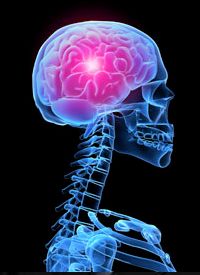Article
Tumor-Treating Fields Extend Survival in Glioblastoma
Author(s):
Adding tumor-treating fields to temozolomide resulted in improved progression-free survival and overall survival for patients with glioblastoma.
brain cancer

Adding tumor-treating fields (TTFields) to temozolomide (Temodar) resulted in improved progression-free survival (PFS) and overall survival (OS) for patients with glioblastoma (GBM), according to a final analysis of results from the EF-14 trial.
The median PFS was 6.7 months for patients randomly assigned to the TTFields/temozolomide group compared with 4.0 months in the temozolomide-alone group (HR, 0.63; 95% CI, 0.52-0.76; P <.001). The median OS was 20.9 months in the experimental group compared with 16.0 months for those assigned to temozolomide-alone (HR, 0.63; 95% CI, 0.53-0.76; P <.001).
Median follow-up was 40 months and minimum follow-up was 24 months.
TTFields (Optune, Novocure) is an antimitotic treatment modality that interferes with glioblastoma cell division and organelle assembly by delivering low-intensity alternating electric fields to the tumor. Investigators delivered TTFields treatment through 4 transducer arrays with 9 insulated electrodes each placed on the shaved scalp and connected to a portable device set to generate 200-kHz electric fields within the brain.
The EF-14 trial enrolled patients from July 2009 to December 2014. The data cutoff was December 28, 2016.
Based on results from EF-14, the FDA approved a second-generation, lighter version of the device in July 2016. The new version weighs 2.7 lbs, about half the size and weight of the original. The first-generation of Optune was most recently approved in 2015 for use in combination with adjuvant temozolomide as a treatment for patients with newly diagnosed GBM following surgery, chemotherapy, and radiation therapy. Optune was initially approved in 2011 for the treatment of recurrent GBM after other surgical and radiation options were exhausted.
A total of 695 patients with grade IV GBM who had completed standard treatment involving surgery, temozolomide, and radiation were randomized within 7 weeks of their last radiation dose to either temozolomide with TTFields (n = 466) or temozolomide alone (n = 229). To be included in the study, participants had a Karnofsky performance score ≥70, histologically proven WHO Grade IV astrocytoma (glioblastoma, GBM), supratentorial tumor location, and nonprogressive disease. Patients were excluded if they demonstrated progressive disease per Macdonald criteria, infratentorial tumor location, and evidence of increased intracranial pressure.
Patient characteristics were similar between the 2 arms: median age in the 2 groups was approximately 56.5 years, and most patients were male (68.5%). The trial’s primary endpoint was PFS based on blinded central radiology review, with OS as the secondary endpoint.
In exploratory analyses, 43% (95% CI, 39-48) of patients were alive at 2 years from randomization, 26% (95% CI, 22-31) at 3 years, and 13% (95% CI, 9-18) 5 years in the TTFields plus temozolomide group. For the temozolomide-only group, 31% (95% CI, 25-38; P <.001) were alive at 2 years, 16% (95% CI, 12-23; P = .009) at 3 years, and 5% (95% CI, 2-11; P = .004) at 5 years.
PFS was 56% (95% CI, 51-61) at 6 months for the TTFields plus temozolomide arm and 37% (95% CI, 30-44) for the temozolomide only arm (P <.001).
An exploratory Cox proportional hazards model adjusting for Karnofsky performance score, MGMT promotor methylation status, geographic region, age, tumor location, and extent of resection was consistent with the findings of the PFS and OS analyses. TTFields plus temozolomide treatment (HR, 0.63; 95% CI, 0.53-0.76; P <.001) was associated with OS as were, female sex (HR, 0.76, 95% CI, 0.63-0.92; P = .005), methylated MGMT promoter (HR, 0.50; 95% CI, 0.41-0.62; P <.001), younger age (HR, 0.978 per year; 95% CI, 0.969-0.985; P <.001) and higher Karnofsky performance score (P <.001). Patients with frontal tumors also had nonsignificantly longer survival (HR, 0.82, CI 0.67-1.01; P = .061).
Investigators found that the addition of TTFields did not lead to a significant increase in rates of systemic adverse events (AEs) compared with temozolomide monotherapy (48% vs 44%; P = .58). Overall incidence, distribution, and severity of AEs were not statistically different in patients in the 2 treatment groups. Investigators observed a higher number of some AEs in the TTFields plus temozolomide group, but concluded that was “a reflection of the longer duration of temozolomide treatment in this group due to delayed occurrence of progression.”
Stupp R, Tailibert S, Kanner A, et al. Effect of tumor-treating fields plus maintenance temozolomide vs maintenance temozolomide alone on survival in patients with glioblastoma: A randomized clinical trial. JAMA. 2017;318:2306-2316. doi: 10.1001/jama.2017.18718.









